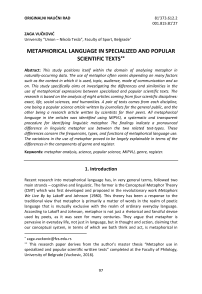Metaphorical language in specialized and popular scientific texts
Автор: Zaga Vučković
Журнал: Sport Mediji i Biznis @journal-smb
Статья в выпуске: 1 vol.8, 2022 года.
Бесплатный доступ
This study positions itself within the domain of analysing metaphor in naturally-occurring data. The use of metaphor often varies depending on many factors such as the context in which it is used, topic, audience, mode of communication and so on. This study specifically aims at investigating the differences and similarities in the use of metaphorical expressions between specialized and popular scientific texts. The research is based on the analysis of eight articles coming from four scientific disciplines: exact, life, social sciences, and humanities. A pair of texts comes from each discipline, one being a popular science article written by journalists for the general public, and the other being a research article written by scientists for their peers. All metaphorical language in the articles was identified using MIPVU, a systematic and transparent procedure for identifying linguistic metaphor. The findings indicate a pronounced difference in linguistic metaphor use between the two related text-types. These differences concern the frequencies, types, and functions of metaphorical language use. The variations in the use of metaphor proved to be largely explainable in terms of the differences in the components of genre and register.
Metaphor analysis, science, popular science, MIPVU, genre, register
Короткий адрес: https://sciup.org/170203625
IDR: 170203625 | УДК: 81'373.612.2; 001.815:81'27 | DOI: 10.58984/smb2201097v
Список литературы Metaphorical language in specialized and popular scientific texts
- Boyd, R. (1993). Metaphor and theory change: What is ‘metaphor’ a metaphor for?. In: A. Ortony (Ed.), Metaphor and thought, 2. Cambridge: Cambridge University Press, 481–533.
- Deignan, A., Littlemore, J., & Semino, E. (2013). Figurative Language, Genre and Register. Cambridge: Cambridge University Press.
- Lakoff, G., & Johnson, M. (1980). Metaphors we live by. Chicago: Chicago University Press.
- Leech, G. (2000). Grammars of spoken English: New outcomes of corpus-oriented research. Language Learning, 50, 675–724.
- Low, G., Todd, Z., Deignan, A., & Cameron, L. (Eds.) (2010). Researching and applying metaphor in the real world. Amsterdam: John Benjamins.
- Semino, E. (2008). Metaphor in discourse. Cambridge: Cambridge University Press.
- Sfard, A. (1998). On Two Metaphors for Learning and the Dangers of Choosing Just One. Educational Researcher, 27(2), 4–13.
- Steen, G. J., Dorst, A. G., Herrmann, J. B., Kaal, A. A., Krennmayr, T., & Pasma, T. (2010). A method for linguistic metaphor identification: From MIP to MIPVU. Amsterdam: John Benjamins.
- Steen, G. (2011). The contemporary theory of metaphor – now new and improved! Review of Cognitive Linguistics, 9(1), 26–64.
- Vuckovic, Z. (2016). Metaphor use in specialized and popular scientific written texts, Master thesis. Belgrade: The Faculty of Philology, University of Belgrade.


